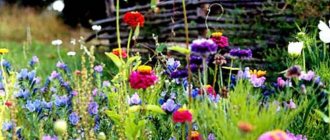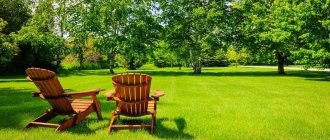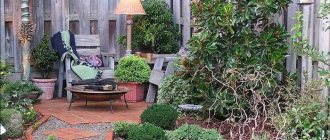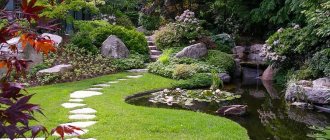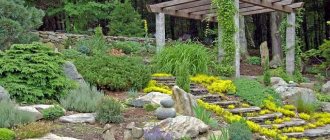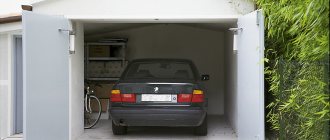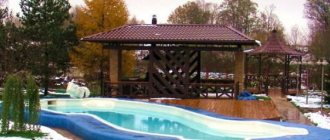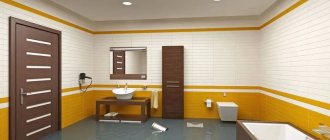One of the main elements in the formation of landscape design is the lawn. It can be used as an independent component or as a background that gives stylistic completeness to the area. A lawn in landscape design not only performs an aesthetic function, but also helps normalize the microclimate, absorbs dust, and reduces noise and vibration levels. As a complement to it, you can use various embankments, natural stones, flowers and other design options, allowing you to create an original design of the site.
The lawn is an integral part of almost any landscape design
Lawn at the dacha: the feasibility of creating grass cover
As a result of the seeds of perennial cereal plants simultaneously planted in fertilized soil, a dense grass covering is formed - a lawn. Its arrangement at the dacha is the right solution to many problems:
- The soft lawn on the site is an ideal place for children to play, play sports, and organize picnics in the fresh air.
The lawn at the dacha is an ideal place for a picnic
- To combat weeds that provoke an allergic reaction in the body, it is advisable to plant the entire area with plant species that are safe for health - meadow bluegrass or clover. Before choosing a lawn base, it is recommended to consult an allergist.
- To level out the feeling of discomfort during the sweltering heat, it is wise to make a grass covering around the entire perimeter of the dacha. It creates a thermoregulatory effect when there is a sharp temperature difference between the soil surface and the air space.
When the temperature changes, the lawn creates a thermoregulatory effect
- Lawn grass is an excellent air purifier. It performs effective filtration: absorbs automobile exhaust gases, dust particles, various combustion products, and prevents the penetration of pathogenic microorganisms from the soil into the airspace. Agronomists recommend using phytoncidal plants in abundance for sowing. They ionize the air and neutralize all kinds of toxic substances.
- To improve the structure of the soil, it is important to use a lawn. A massive grass floor retains moisture in the soil.
The lawn will improve the soil structure
- To reduce the power of earth vibration, it is wise to surround the house and various buildings with neatly trimmed cereal plants. Owners of households located near highways should pay close attention to this feature.
Thick grass cover is the best source of oxygen, contributing to the excellent well-being of others.
Content
- Easier to fix than to replace
- Lawn of ground cover plants
- Defining the goal
- Choosing a form
- How to visually smooth straight lines
- Non-standard forms
- Round lawn
- Lawn Borders
The lawn most often occupies the main, central part of the site and must strictly correspond to the general appearance of the garden and the lifestyle of its owner. After all, it is the lawn that plays the role of the main background on which all other elements of the garden are placed.
pixnio.com / Personal archive
Types of lawn at the dacha
Low-growing perennial plants are optimal for landscaping the garden area. The purpose of the grass turf influences the choice of lawn type:
- Landscape gardening is actively used to organize recreation areas on the ground. Plant varieties with soft stems and leaves will create a pleasant feeling while sitting, lying, or walking without shoes. The green base is characterized by its resistance to stress, the ability to quickly restore its original appearance, good growth in shaded areas and under intense sun exposure. It is planted around trees, bushes, benches, paths, artificially created ponds and other architectural structures.
Landscape lawn is suitable for recreation areas
- Sports is necessary for organizing a football field or playground for children. A characteristic feature is planting a certain area of soil with plants with increased rigidity of stems and a strong root system. Dense turf under heavy loads quickly recovers not only under the influence of athletes’ feet, but also when driving vehicles.
- The ground floor is an indispensable element of the design of a dacha in the English style. It is used to decorate the site. To equip it, you need seeds of monochromatic plants of a bright green tone, capable of growing slowly and forming a dense topsoil layer. You cannot walk on the ground lawn. Otherwise, bald spots and voids will first appear on it, and then it will quickly trample.
Ground lawn for a summer cottage in English style
- Moorish is a remarkable decoration of a summer cottage. It plays a purely decorative role. To form it, it is necessary to sow with flowering field plants. At the final stage of growth, a colorful lawn is formed on the soil, embodying the pristine beauty of nature.
The Moorish lawn plays an exclusively decorative role
A rolled lawn will delight you with its spectacular appearance just a couple of weeks after it is installed in the desired areas of the site. To successfully implement the idea of gardening a dacha, you need to study in detail the key points of organizing seed, roll or Moorish lawn turf.
Park and meadow lawn
To create a park lawn, it is customary to use perennial cereal crops, for example, a mixture of bentgrass, timothy, fescue and comb grass. Meadow areas are usually used to design parks and other public areas, but they can also be used when creating landscape design for a personal garden. At the same time, experts recommend not to lay out this lawn in front of the entrance to the house, placing it closer to the fence or the back of the yard. Plants used to create a park lawn require sunlight to ensure their proper growth.
Features of choosing grass for a sowed lawn
Creating your own grass flooring on the ground provides the opportunity to choose plant varieties that are ideally suited to the type of soil in your dacha, climate and aesthetic taste. The primary task is to select a base that can perform a utilitarian and decorative function. Having decided on the purpose of the lawn, you should choose plant seeds in accordance with the desired effect:
- Lawn grasses that are excellent weed killers include bentgrass, red fescue and bluegrass. They perfectly displace harmful plants, withstand severe frosts and drought, and require moderate watering. When choosing a base, you should take into account their color. Bluegrass forms a soft carpet of rich green color on the soil. Red fescue easily colors the ground with a jade tone with rare splashes of dove and sky colors.
Soft, deep green bluegrass lawn
- To beautifully decorate the soil around landscape design elements, it is advisable to plant sheep fescue. It looks elegant due to its long, needle-like stems of dark green color. The bush structure forms a dense grass cover that resists trampling and sunburn.
Fescue lawn is resistant to trampling
- For a parterre lawn used as a natural decoration for a summer cottage, it is optimal to choose perennial ryegrass. This plant has an unusual malachite color with shiny, arrow-shaped leaves that shine in the light. Ryegrass seeds germinate instantly. Due to its intensive growth, loose bush grass requires frequent mowing in order to give the lawn turf an aesthetic appearance.
Perennial ryegrass for parterre lawn
The main criteria for choosing grass for forming a lawn are adaptability to climatic conditions and growth period. Bluegrass and ryegrass are annual plants. Therefore, with the arrival of spring, the lawn must be renewed annually. Red fescue, comb grass, and multicolored ryegrass can delight with uniform growth and density of grass cover for many years.
Variety selection
A beautifully designed lawn is most often made from perennial grasses. They do not require regular updating and are unpretentious. The peculiarity of plants is their long development period from the germination stage to flowering, which allows them to maintain a neat appearance throughout the entire season.
Choosing the right grass is the key to success Source bestremoont.ru
Soft fescue from sheep Source kvetok.ru
In the ranking of ten perennial grasses for a beautiful lawn, the leaders are:
- Sheep fescue (Festuca ovina) grows well on lawns with poor soil and does not require fertilizing or watering. The bright color of the foliage is maintained during dry periods and when planted in the shade. It germinates immediately after the snow melts and is not afraid of trampling and frequent mowing.
Saturation of red fescue Source gazonoclub.ru
- Red fescue (Festuca rubra) – creates strong shoots underground, quickly covering empty spaces. It tolerates weather disasters and sudden temperature changes that have become more frequent in recent years. Capable of growing on any type of soil.
- Meadow fescue (Festuca pratensis) - in comparison with red fescue, it is more whimsical and afraid of trampling, nevertheless it is popular in lawn sowing. It has a powerful root system that penetrates up to 1.5 m deep.
- Meadow bluegrass (Poa pratensis) - germinates quickly in the spring. Belongs to the cereal family. It sprouts without problems after winter, and such a lawn reaches full development 3-4 years after planting.
Healthy! Meadow bluegrass does not germinate well on lawns with highly acidic soil.
Common bentgrass, thin or filamentous (Agrostis capillaris) Source chrome-effect.ru
- Common bentgrass, thin or filamentous (Agrostis capillaris) – resists weed germination well. To organize a beautiful lawn, it requires regular mowing to a height of 5-8 cm.
Dog bentgrass, or velvet bentgrass (Agrostis canina) Source sad.ukr.bio %
- Dog bentgrass or velvet bentgrass (Agrostis canina) - has a shortened creeping root that forms a durable grass carpet. Not afraid of areas saturated with moisture.
White bentgrass prefers moist soil Source all-begonias-tamaravn.blogspot.com
- White bentgrass (Agrostis alba) is a plant with soft, rough leaves, no more than 7 cm long. It tolerates spring frosts well, and preferably grows on moist soils.
Perennial, perennial or English ryegrass (Lolium perenne) Source www.plantarium.ru
- Perennial ryegrass, perennial or English (Lolium perenne) - develops well already in the first season after sowing. When used as lawn grass and regularly mowed, it lives no more than 4 years. The leaves are soft and have a bright, rich color.
Bekmania vulgaris is often confused with sedge Source skotovodstvo.blogspot.com
- Beckmania eruciformis is unpretentious to frequent mowing, flooding, and trampling. A powerful root system forms durable turf.
Multi-flowered ryegrass (Lolium multiflorum) Source www.plantarium.ru
Advantages of rolled lawn
Incredible soil transformations in a summer cottage can be easily and incredibly quickly accomplished using a mobile grass flooring. Rolled lawn is a multi-layered canvas consisting of a soil substrate and densely sprouted grasses.
It consists of professionally selected different plant varieties that form a three-layer coating. At the lower level there is a densely intertwined root system with soil, at the middle level there is a mesh for the shape stability of the grass, at the upper level there are stems and leaves with a length of no more than 5-7 cm. A green carpet with a soft “living” covering can be spread anywhere in the dacha on a moistened soil.
Rolled lawn can be placed anywhere
The undoubted advantages of rolled lawn are its unique features:
- Minimum time required to create a grass floor on the ground. In a matter of hours, the earth will be covered with a colorful blanket of greenery.
- The rolled base can easily take any desired shape. When using a garden knife, it can be easily cut in accordance with the straight or curved configuration of landscape design details - gazebos, flower beds, paths.
Rolled lawn takes any desired shape
- When forming a grass base, universal plants are selected that easily adapt to any living conditions - windy, shaded, places in the sun, with an abundance of moisture and the influence of low air temperatures.
- If the rolled canvas is deformed, it is easy to correct the defect by cutting it out and filling it with fresh lawn turf.
- Weeds don't grow on it.
Rolled lawn is easy to install
Rolled lawn is so easy to install that any summer resident without gardening skills can refresh the area in the spring-summer season. In urban conditions, grass with a soft velvet surface will look the same for 5 years, and outside of it, away from dusty areas, for over 10 years.
Options for designing a lawn in front of the house
The space in front of the house requires special attention, since it is where the first impression of the site and housing is formed. That is why the question of how to make a lawn in front of the house is relevant for many homeowners. It is not recommended to divide your lawn into small areas as this can make it difficult to maintain. A single lawn will be an excellent backdrop for placing decorative elements on it.
A small ground lawn in front of the main entrance to the site
The lawn near the house can be supplemented with flower beds or small paths that are laid out from the gate to the entrance to the room. A few large objects will look better than many small ones, so you should not overdo it in using them. You can decorate the planting with vertical free-standing flower beds or vines framing the gazebos.
Children playing on a grass playground will bring less dirt home
Distinctive features of the Moorish lawn
If you want to admire the flowering meadow outside the window of your country house every day, it is rational to choose an unusual way to improve the land. The most natural landscape, illuminated with a riot of colors of flowering wild plants and herbs, is a unique feature of the picturesque-looking Moorish lawn.
It is amazingly suitable for decorating the surrounding area of the house, a garden with fruit trees. A beautiful “living” carpet with multi-colored colors perfectly neutralizes the effect of emptiness on large areas of land without buildings. It does not need to be framed by a fence.
Moorish lawn to decorate the surrounding area
Organizing a Moorish lawn requires a careful selection of cereal plants. An ideal soil cover will be made from 80% wildflowers and 20% grasses. As a flowering base, you can use the seeds of poppies, cornflowers, dandelions, forget-me-nots, and daisies. The more different types of colorful plants are present on the plot of land, the more impressive the colorfully decorated “Moorish” carpet looks. Meadow bluegrass and clover seeds are excellent for forming a grassy layer. Due to the variety of plants growing differently, this type of lawn grows in a chaotic direction and does not have clearly defined boundaries.
Green lawn of clover
Caring for a decorative lawn is labor-intensive due to regular weeding, fertilizing, and watering the soil. It can be built on any type of soil. Taking care of it is moderately difficult due to the lack of the need for frequent trimming. It is enough to cultivate the soil with a lawn mower after the seeds have germinated and the flowering period has ended. The height of the plants after mowing should be at least 10 cm. Due to the extremely rare cutting of the grass cover, it is impossible to give it a certain shape. This is the individuality of the Moorish lawn, recreating the natural appearance of an endlessly blooming field with the divine aroma of wildflowers.
Selecting a location
Choosing a place for a beautiful lawn takes into account the amount of sunlight, the type of soil and its moisture content. On most sites it is not possible to choose the ideal place, but there is always the opportunity to complete what nature did not provide. The main thing is to study what is already available and take appropriate measures.
- Location relative to cardinal directions. The amount of sunlight hitting your beautiful lawn depends on which direction it faces. Please note: cold winds most often blow from the east or north. Dank damp ones - from the west and southwest. Therefore, a garden facing south will receive more hot sun, and one facing north will receive excess shade.
- Terrain. A beautiful green lawn planted on a slope does not tolerate strong winds. Smooth, on the contrary, but here there is a possibility of deep shadow, excess moisture, or vice versa: a lot of light and little water.
Autumn still life Source www.goodfon.ru
Advice! Lawns laid out in the sun require special care: abundant watering and not too short trimming (shade from the leaves protects the roots from drying out).
- Shade and lack of moisture. Grass planted close to buildings and fences will lack moisture. This happens due to the so-called “rain shadow”, since in most cases the drops fall at a slight angle. A similar situation occurs on lawns where garden trees cast shadows. The leaves on the lawn become pale in color and follow the sun, becoming an easy victim of fungal diseases. In autumn, under a layer of fallen leaves, they lack light, which also leads to the appearance of harmful microorganisms.
See also: Catalog of companies that specialize in landscaping work on sites.
Subtleties of soil preparation when arranging a lawn
If there is not enough time to improve the dacha area, the option of creating a roll-type grass cover is relevant. If you want to save a lot and add a personal touch to the landscape design of your site, it is advisable to make a lawn at your dacha yourself.
The soil preparation technology is extremely simple and straightforward:
- Marking boundaries. It is necessary to clearly mark the place for sowing lawn grass when using rods or sticks covered with rope.
Marking boundaries for sowing a lawn at the dacha
- Soil cultivation. Before sowing, the soil must be cleared of stones, stumps, snags, all kinds of roots, and weeds. The easiest way to combat harmful grass is to treat the soil with herbicide mixtures.
- Soil fertilization. To do this, it is worth using a mixture of slaked lime and crushed chalk, vermicompost, and humus. In the spring, it is important to fertilize the soil with nitrogen fertilizing, which promotes the progressive growth and full development of plants. In autumn, the soil needs to be fertilized with mixtures containing phosphorus and potassium, which strengthen the root system for painless wintering.
Fertilizers will strengthen the lawn's root system
- Leveling the area. To compact the soil and create a perfectly flat surface, use a manual or mechanized roller with a weight of more than 100 kg. Any uneven ground needs to be corrected.
Compacting and leveling the soil
- Soil shrinkage. During the half-moon, the earth should become denser. Therefore, it needs to be moisturized regularly.
Only in fertile, loosened, intensively drained soil will plant seeds instantly germinate and bloom. After successful earthworks, you can plant lawns at your dacha with your own hands. Photo instructions from experienced gardeners will make it easy to cope with the task of preparing the soil for planting cereal plants.
Expert advice
Before you set up a lawn, you should understand what is closer to you - an artificial or natural option. It is also important to decide on the purpose - sporty or decorative. The artificial version will not cause difficulties; creating a natural design will have to work hard.
Before planting plants on top, make sure the base is well prepared. It is important that there is no stagnation of water in the soil. It is also worth weeding the weeds thoroughly. You should sow according to the instructions for each plant. It is important to follow the regime of fertilizing and watering.
It doesn’t matter whether you choose a butterfly or lizard design, you should follow the advice of experts:
- Watch the lighting - shade-loving grass mixtures are planted in the shade, light-loving ones - in the sun.
- If your area is intended for play, choose artificial grass.
- The soil for the Moorish lawn should be selected as carefully as possible.
- At the dacha, soil preparation should be carried out using the method of reclamation and mechanized means. Reclamation can be carried out using organic fertilizers and peat, by mixing soil and black soil.
These tips will help you keep your lawn tidy. By following them, you will certainly achieve good results.
Choosing the optimal season for sowing
The ideal time to plant lawn grass is from early spring to late autumn. Each period of the year except winter has advantages and disadvantages:
- In the spring, under conditions of warm soil, moderate air humidity, and loyal sun exposure, cereal seeds actively germinate. Together with them, weeds sprout, slowing down development and displacing herbaceous plants.
- At the beginning of summer, there is absolutely no chance of frosts that have a detrimental effect on young, immature lawn grass. Heat has a negative effect on sprouts. Direct rays of the sun provoke lethargy and drying of seedlings. The ideal time for planting is the heavy rainy season with an average daily temperature of 20-25 °C.
- In autumn, it is recommended to carry out sowing work at the beginning of September or before the arrival of winter. If the lawn base is planted immediately after the end of the summer heat, it will germinate well before frost with abundant artificial and natural watering. If the seeds are sown in slightly frozen soil before snow falls, they will sprout only in early spring. Over the winter they will take root and begin to withstand the effects of frost and wind. With the arrival of warm weather, the soil will warm up, provoking abundant growth of cereal grasses.
It is recommended to sow from early spring to late autumn
Easier to fix than to replace
- If you are planning to change an existing lawn design or create a new one, try to keep what you have or simply modify it.
- Expanding, reducing or changing your lawn is much easier than creating it from scratch.
- The most labor-intensive part when changing the design of a lawn is digging and reseeding , which, by the way, can also be avoided if the lawn is not completely bad and repairs can give good results.
- If there is a need to change the shape of the lawn, then you can simply get by by cutting out the turf from unnecessary areas and moving them to the right places.
Yoshihide Nomura / Flickr.com
hippopx / Personal archive
How to plant a lawn at your dacha with your own hands: step-by-step sowing instructions
Having chosen the optimal time, you should begin sowing:
- For this process you need to choose calm weather.
- Pre-moisten the soil.
- To evenly distribute seeds throughout the area, it is recommended to use a seeder.
Seeder for uniform seed distribution
- When sowing by hand, you need to mix the seeds with sand. This will help scatter them evenly across the soil. They need to be distributed alternately in two opposite directions: along and across the site.
- At the end of sowing, the soil should be loosened with a rake and the position of the seeds should be fixed with a roller. To prevent the wind from blowing them out of the soil, you need to cover them with a layer of peat no more than 1 cm deep.
Low-growing grasses that do not require regular “haircuts” are perfect for inconvenient and hard-to-reach areas when mowing.
On curved terrain, it is wise to use twice as many seeds as on flat ground. During heavy rains on sloping areas, they are easily washed away by water flow. To plant a dense lawn, you need to disciplinedly adhere to the sowing norms indicated on the seed packages.
Low-growing grasses do not need regular trimming
To make maintenance easier, it is important to form grass turf with the help of perennial plants. For easy replanting of annual grasses, it is worth planting them along the edges of the lawn cover.
When preparing the soil yourself and sowing seeds, the time for the formation of a grass layer on the soil ranges from several months to one year.
What and how to fertilize
The green lawn is fertilized in spring, summer and autumn. This is done in different ways, but summer residents prefer spraying fertilizers.
In order for the lawn to emerge from winter as quickly as possible, it is recommended to fertilize it with nitrogen or phosphorus fertilizers. The grass is fed as soon as the snow melts. In this case, both liquid and solid fertilizers are applied.
In summer, your lawn needs more nutrients. Therefore, the ideal solution would be to use mineral fertilizers. It is recommended to apply them at the end of June - beginning of July.
In autumn, attention is paid to the application of nitrogen fertilizers, which will help the grass to survive the winter well. The lawn is fertilized two weeks before the first frost.
Rules for lawn care
In order for the grass cover to always be in a fragrant condition and delight the owners of the dachas with the richness and brightness of its greenery, you need to take care of it in a timely manner:
- Install automated watering systems with a fine water spray. Turn on underground sprinklers regularly in the morning and evening. When watering by hand, be sure to use a hose with a spray nozzle. Otherwise, strong water pressure will wash away the soil and deform the root system of plants.
Automated watering system
- Mowing should be carried out when plants are longer than 10 cm. The strength of the plant root system depends on the frequency of mowing the lawn. Use lawn mowers or trimmers to cut grass.
- Aerate the soil. As a result, the cereals will receive a flow of air, water and natural minerals that has a beneficial effect on their growth.
Lawn aeration
- Organize fertilizing of soil with a deficiency of fertile layer.
- Fight weeds.
Recommendations for using lawn in landscape design
There are a number of tips that will help keep your lawn looking attractive and prevent it from overgrowing and drying out:
- Timely and correct haircut. It is not recommended to cut the grass very short. Haircut frequency: up to 2 times a week (more often in summer, less often in autumn). Before the procedure, it is recommended to comb the grass to avoid the growth of weeds.
- Aeration of the soil, due to which it is enriched with oxygen. For this, a rake or special fork is used.
- Timely and moderate watering. The procedure is carried out only in the evening using a spray. Puddles should not be allowed to appear, as they contribute to plant rotting.
- Feeding. Fertilizers are applied after each cutting, and their type depends on the type of seeds planted.
- Regular correction of the boundaries of the planting, which will give it the desired appearance.
The lawn on the site gives the impression of order, and well-groomed plants perfectly complement the landscape.
Lawn mowing
Lawn aeration
Combing the lawn
There are many photos of the design of lawns in front of the house, where you can see popular and exclusive options. The use of different grasses, thoughtful design and care will allow you to enjoy the beauty of the lawn for a long time, play on soft grass with children or host various events.
How to decorate the landscape of a summer cottage with a lawn
Caring for a healthy and clean environment is the main trend of modern landscape design. The abundance of cereal plants in the summer cottage intensively produces crystal clear oxygen. In addition to its beneficial health function, the lawn looks aesthetically pleasing in any form.
The composition of the seed determines the design of the lawn surface. It can have a variable form:
- graceful smooth lines of soil with a perfectly even grass surface of emerald color in the traditional design are obtained when planting cereals of the same type;
- alternating straight stripes of light and dark green tones are created by alternately sowing grasses of the corresponding color;
- checkerboard lawn covering is made using different varieties of plants with radically different colors;
Checkerboard lawn covering
- curly ornaments and patterns in the form of zigzags, spirals, circles and other shapes can be cut out on the grass using a lawn mower;
- the effect of a multi-colored textile covering on the ground can be easily created by planting many-sided meadow flowers mixed with herbs of mustard, olive, and mint tones;
- a multi-level lawn looks original on multi-story architectural structures on a summer cottage, provided that each level of the building is decorated with grasses with a colorful color different from each other.
Multi-level lawn looks original
The appearance of the land cover represents the stylistic concept of the landscape design. If the dacha visually resembles a strictly designed garden in the English style, then it is optimal to opt for a ground lawn. If you want to decorate a suburban area in a rustic style, it is wise to create a rustic atmosphere by arranging a meadow or Moorish lawn with an abundance of wildflowers.
The lawn at the dacha gives the impression of impeccable order. A perfectly flat grassy ground cover will focus the attention of those around you on the careful care of the local area. The lush greenery of forbs creates a natural idyll. Properly planted and well-groomed lawn grass can turn a standard-looking piece of land into a heavenly place for a complete relaxation in the country, where the air is thoroughly saturated with the aroma of herbs and floral amber.
Types of decor: artificial and natural
Artificial lawn differs from natural lawn in that the soil is specially prepared and the surface is equipped with a flooring that visually resembles natural lawn. Artificial decor is usually made of dense plastic, which does not harm the environment.
Natural lawn is a seedling of special types of grass. Caring for natural decor is much more difficult, but its appearance is much better. There are several types of natural lawns that are in demand among people who have their own garden plots and owners of suburban houses.
Photo gallery - lawn at the dacha
How to visually smooth straight lines
- You can place some figurine or sculpture on such a lawn.
- It could also be a birdbath, a sundial, a fountain, decorative screens, or a flower girl in the shape of an old bicycle.
- You should not place such items in the center of a rectangular lawn. It is better to choose the edge closest to the flower bed, or a point at the rear border, to which the observer’s gaze will slide.
You can also change the impression of a rectangular lawn by placing it diagonally . Such a lawn will look much more interesting if it is positioned at an angle of 45º.
- There is no need to completely redo You simply remove in certain places and transfer it to a new, prepared place.
- The only point is that other structural elements of the site should be in harmony with the diagonal lines of the lawn. And such elements can be screens, screens or plants planted along the same diagonal.
Main stages of care
To form a beautiful lawn and maintain its condition, you need to regularly or as needed:
- water;
- cut;
- weed;
- mulch;
- feed;
- pierce (aeration).
Grass is also sometimes sowed if mistakes were made during the care process and empty spaces appeared.
Watering
As soon as the grass becomes limp, you need to water the lawn. This is important to prevent the lawn from turning gray. Need to water:
- in the morning or evening;
- to well-moistened soil;
- clayey soils are less common, and sandy soils are more common;
- when the soil has dried out a little to prevent the roots from rotting.
It is easier to water a larger area well using a motor pump or garden pump.
Cutting and removing weeds
The first cutting is carried out around mid-May, when the grass has grown to 10 cm. It is important to do it before rainfall, if any is expected. Wet grass becomes heavy and presses to the ground, making it difficult to trim. A repeat operation is carried out when the grass rises to 6-8 cm. It needs to be cut to a height of 4 cm.
The frequency of mowing depends on the type of grass sown, for example, for fescue and ryegrass - once every 10 days, bluegrass - once a month. The correct cutting direction is perpendicular to the previous haircut or diagonally.
Electric or gasoline lawn mowers are used for cutting. Before work, the lawn surface is cleared of sticks, stones and other debris so as not to damage the equipment. Grass near curbs and other hard-to-reach places is removed with a trimmer.
The last haircut is performed before frost and always on a day when frosty winds do not blow. Cold gusts can cause the tips of the plants to freeze and the grass will not germinate well next season.
Hedge options
To design the boundaries of a lawn or paths, you can use not only borders and fences. For these purposes, professionals are increasingly resorting to creating hedges that harmoniously fit into any landscape of the site. Equipped low borders up to 1 meter high clearly define the outlines of lawns, walking paths and flower beds.
Depending on the plants used, hedges can be:
- conifers;
- deciduous;
- curly;
- curbs.
Hedges can also be unshaped, which are not trimmed, or molded, which require regular trimming to maintain their shape. Living borders made from low-growing decorative deciduous shrubs, which do not exceed 45 cm in height, look very elegant.
Also read about what to feed your lawn at different times of the year.
The width of such a living border is about 50 cm. When planting plants, you should think about the overall composition. The fence should not only protect individual elements, but also harmoniously combine with the overall concept of the garden and support the given style of the flower arrangement.
The most suitable plants for creating a living border are:
- thyme;
- sage;
- lavender;
- cuff;
- marigold:
- saffron;
- daisy;
- kochia.
Among the decorative deciduous low-growing shrubs, boxwood, barberry, honeysuckle, cinquefoil, and cotoneaster should be noted. Hedges made from border roses and rhododendrons look very elegant.
Ideas for fencing a lawn from a flower bed
In order for the lawn to have clear boundaries and the flower garden to look well-groomed, all kinds of fences, fences and borders are widely used in landscape design. Thanks to such elements, flower beds and the edge of the lawn have a finished look.
Did you know? If you wrap the lower part of a wooden fence in roofing material before burying it in the ground, you can achieve maximum protection of the material from rotting. Such a fence will have a longer service life.
There are many types of fencing, differing in shape, material of manufacture, installation method and cost, which can be purchased at construction supermarkets. And there are those that you can build yourself, using your imagination and without incurring significant costs.
Forged or welded metal fence
Welded structures are considered the most commonly used. To make a fence, use a rod with a round or square cross-section up to 10 mm thick; it is better not to use material less than 6 mm. Having pipe cuttings, pieces of fittings and a welding machine, you can make your own fencing.
Learn how to grow a lawn in a weed-filled area.
The work consists of the following stages:
- Think over a shape or design based on the available material.
- Measure and lay the future structure on a plane.
- Using a grinder, cut and adjust the parts to size.
- Weld the elements into a single structure.
- Dig a trench along the entire perimeter of the bed and fill it with concrete.
- Cut pins from the reinforcement and place them throughout the trench at the same distance. It is to these pieces of protruding reinforcement that the fence will be mounted in the future.
- Weld the prepared fence fragments to the pins.
A wrought iron fence will become a truly exquisite decoration for your lawn. Such fencing is most often made to order and is distinguished not only by the beauty of the work, but also by its high cost.
- Like any other product, metal fencing has some disadvantages:
- in hot weather, the fence heats up and can cause burns on plants;
- Openwork forged products are difficult to paint, and their role on the lawn is more aesthetic than functional.
- Metal structures have a number of advantages:
- Long service life . The fences are treated with special anti-corrosion compounds, which significantly reduce the influence of natural factors on the material.
- High aesthetic characteristics . The ability to make custom-made products will make your lawn unique.
- Reliability of the material . Metal structures can withstand large mechanical loads.
- A wide range of . On the market for such products you can find fences of various shapes, colors and sizes.
- Easy to care for . They won’t require much trouble, and the fence can be returned to new condition with timely painting.
Concrete structures
Garden fences made of concrete are widely used to delimit flower beds, paths and lawns. Making a low fence or border from such material is a reliable and easy-to-execute method.
You might be interested to know if you can seed your lawn in the fall.
There are two options for creating concrete curbs:
- using dry concrete;
- production from raw mixture.
The process of creating a fence from dry material consists of the following steps:
- Mark the curb. This will require rope and pegs.
- Remove the top layer of soil. The approximate depth of the ditch is 15 cm.
- Manufacture and install formwork and spacers.
- Prepare a mixture of cement and sand.
- Pour the composition into the recess and compact it.
- Level the top of the structure and give the border a neat appearance.
- Apply a layer of water repellent, which protects the concrete from moisture, temperature fluctuations and corrosion.
It will take a little more time to make a fence from raw concrete.
The work is carried out in the following order:
- Mark the outline of the curb.
- Dig a ditch 10 cm deep and 20 cm wide.
- Install wooden blocks or pegs along the entire perimeter, the distance between which should not exceed 45 cm.
- Attach the fiberboard to the bars.
- Fill the prepared recess with mortar and carefully level it.
- Once the concrete has set, acrylic sealant should be applied to the curb.
- It will take at least five days for the structure to dry completely.
The modern building materials market offers a wide range of finished products. Products may differ in shape, color, and various sizes.
Why separate the lawn from the flower bed?
When composing garden compositions from flowers, lawns, and shrubs, many do not think about ways to differentiate all these elements from each other. Over time, the plants grow and a fight for territory begins. Plants from the flower garden appear on the lawn, but the flower bed dies under the pressure of cereal grasses.
For the successful coexistence of a lawn and a flower bed, it is necessary:
- clear separation of plant materials used to cover the soil;
- correct delineation of levels and joints of the flower bed and lawn;
- separating areas covered with gravel, pebbles, bark or any other material from planting areas.
By paying due attention to the arrangement of the lawn and flower beds, in the future you can obtain a highly aesthetic, pleasing effect to the eye, and also save yourself from possible problems with the spontaneous movement of plants.
Non-standard forms
- Smooth, winding lines will also look beautiful Such lawns are ideally combined with ribbon flower beds, island flower beds and landscape plantings.
Gray Rocker / Flickr.com
- An interesting and non-standard solution would be to change the level of the lawn in certain areas. This will look especially impressive The difference in height level can be 15-25 cm.
DrNickStafford / Personal archive
- The lawn can be raised or, conversely, “ submerged .” Such a lawn will require mandatory border design and a thoughtful approach to the lawn mower. Stone or brickwork will look beautiful and stylish in this role . Such an element of garden decoration will definitely not go unnoticed.
